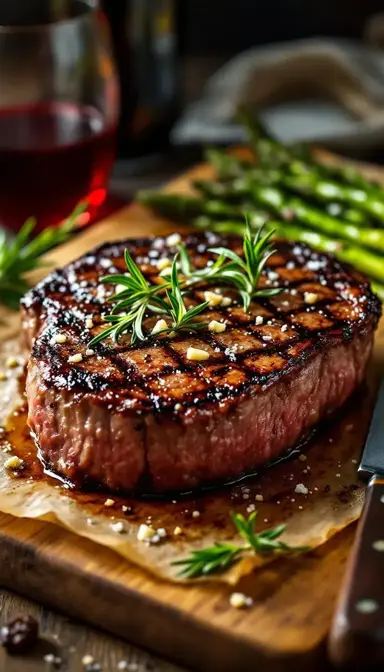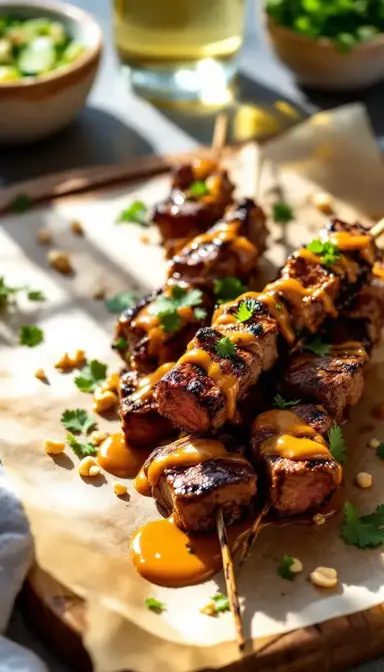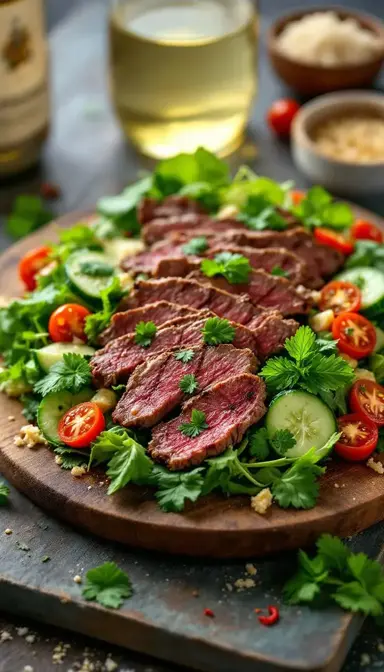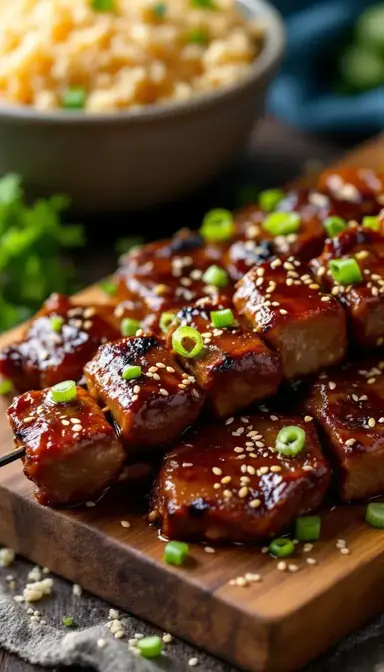There’s something undeniably special about a perfectly grilled Porterhouse steak. It’s the kind of meal that turns an ordinary evening into something memorable—a thick, juicy cut that combines the buttery tenderness of filet mignon with the bold, beefy flavor of a New York strip. Picture this: a golden-brown crust giving way to a rosy-pink center, the aroma of garlic and rosemary mingling with the smoky char of the grill. This isn’t just dinner; it’s an experience.
Why This Recipe Works
- Thickness is everything: A 1.5 to 2-inch-thick steak ensures that perfect balance of sear and succulence. Too thin, and you risk drying it out. Too thick, and you’ll struggle with uneven cooking.
- Dry-brining is a game-changer: Salting the steak ahead of time isn’t just about seasoning—it transforms the texture, making every bite juicier and more flavorful. The salt draws out moisture initially, then allows the steak to reabsorb seasoned liquid, enhancing tenderness.
- High heat = maximum flavor: A screaming-hot grill (500°F or higher) locks in juices and creates that irresistible crust through the Maillard reaction, a chemical process that develops complex flavors.
Essential Ingredients & Tools
Ingredients for the Steak
- 1 (24–32 oz) Porterhouse steak, 1.5–2 inches thick – Look for even marbling and a thick filet side. USDA Prime is ideal, but a well-marbled Choice cut will still shine.
- 1 tbsp coarse kosher salt – This isn’t the time for fine table salt. The larger grains adhere better and draw out moisture for a superior crust.
- 1 tbsp freshly cracked black pepper – Freshly ground makes all the difference. Pre-ground pepper loses its punch.
- 2 tbsp high-heat oil – Avocado or grapeseed oil can take the heat without smoking excessively. (Vegetable oil works in a pinch.)
- 3 sprigs fresh rosemary – Or thyme, if you prefer. That herbal aroma is half the magic.
- 4 cloves garlic, lightly crushed – No need to mince; we’re after subtle infusion, not overpowering bite.
Optional Finishing Butter
- 2 tbsp unsalted butter – A cold pat melting over the hot steak is pure indulgence. (Ghee works for dairy-free.)
- 1 tsp flaky sea salt – That final sprinkle? Chef’s kiss.
Tools You’ll Need
- A grill (charcoal or gas) – Charcoal adds smokiness, but gas offers precision. Both work beautifully.
- Instant-read thermometer – Guessing doneness is a gamble. A thermometer is your best friend. (A basic analog one works if you don’t have digital.)
- Heavy-duty tongs – No stabbing the steak—those juices are precious.
- Cutting board with a groove – Because nobody wants to lose those savory resting juices.
- Basting brush – For an even coat of oil without overdoing it. (A folded paper towel works in a pinch.)
How to Make Grilled Porterhouse for Two
- Dry-brine the steak: Pat the steak thoroughly dry with paper towels—this ensures the salt adheres properly and promotes a crisp crust. Season all sides liberally with 1 tbsp coarse kosher salt. Place the steak on a wire rack set over a tray and refrigerate uncovered for 1 hour (or up to 24 hours for deeper penetration). This process, called dry-brining, draws out moisture initially, then allows the steak to reabsorb seasoned liquid, enhancing flavor and tenderness.
- Preheat the grill: Fire up your grill to 500°F (260°C) for direct high-heat cooking. If using charcoal, arrange the coals in a tight, even layer for consistent heat. For gas grills, preheat all burners on high for 15 minutes with the lid closed. Pro tip: Place an oven thermometer on the grill grates to verify the temperature—many built-in dials are inaccurate.
- Oil and season: Remove the steak from the fridge and let it sit at room temperature for 20 minutes to promote even cooking. Brush both sides lightly with 2 tbsp high-heat oil, then press 1 tbsp freshly ground black pepper onto the surface. Avoid salting again—the dry brine did the heavy lifting.
- Sear the steak: Place the steak on the hottest part of the grill at a 45-degree angle to the grates for crosshatch marks. Grill undisturbed for 4–5 minutes to develop a deep crust (this is the Maillard reaction—a chemical process that creates complex flavors through browning). Flip once using tongs (never a fork, which pierces the meat and loses juices) and repeat on the second side. For medium-rare, aim for an internal temperature of 130°F (54°C)—check with a thermometer inserted horizontally into the thickest part of the filet side.
- Add aromatics: In the last 2 minutes of grilling, toss 3 sprigs fresh rosemary and 4 cloves crushed garlic directly onto the grill grates near the steak. The smoke will infuse the meat with herbal, savory notes. For extra richness, place a pat of 2 tbsp unsalted butter on the steak during the final minute to baste it as it melts.
- Rest and finish: Transfer the steak to a grooved cutting board (to catch juices) and tent loosely with foil. Resting for 10 minutes allows the fibers to relax and juices to redistribute—skipping this causes up to 30% moisture loss. Just before slicing, sprinkle with 1 tsp flaky sea salt for a burst of texture and flavor. Cut against the grain (perpendicular to the muscle fibers) for maximum tenderness, separating the strip and filet portions first.
Pro Technique
Reverse Sear for Thick Cuts
For steaks over 2 inches thick, the reverse sear method guarantees edge-to-edge perfection. Slow-roast the steak in a 275°F (135°C) oven on a wire rack until it reaches 115°F (46°C) internally—this gentle heat minimizes the gray band (the overcooked layer near the surface). Finish on a 500°F (260°C) grill for 60–90 seconds per side to develop a crust. Ideal for fuss-free timing when entertaining.
Banked Coals for Control
When using charcoal, pile 75% of the coals on one side of the grill to create two zones: searing-hot direct heat and cooler indirect heat. Sear the steak over the coals, then move it to the cooler side if flare-ups occur or to gently finish cooking. This mimics a professional steakhouse broiler.
Chef’s Wisdom
Picking the Perfect Porterhouse
Look for a steak with a symmetrical T-bone and a filet portion at least 1.25 inches wide—this ensures both sides cook evenly. Avoid steaks with thick exterior fat caps (wasted weight) or excessive silverskin (connective tissue that won’t render). Prime-grade beef offers the best marbling, but Choice-grade works well if budget-conscious.
The Truth About Resting
Many home cooks slice steak immediately, fearing it’ll cool too much. In reality, a properly rested steak loses only 5–10°F (3–5°C) under foil—and the wait ensures juiciness. For a warm serving, preheat plates or add resting juices back after slicing.
Storage & Freshness Guide
Raw Storage
Store uncooked Porterhouse in its original packaging on the bottom shelf of the fridge (to prevent cross-contamination) for up to 3 days. For longer storage, vacuum-seal and freeze for 3 months. Thaw in the fridge overnight—never at room temperature.
Leftovers
Wrap cooked steak tightly in butcher paper or foil (not plastic wrap, which traps steam) and refrigerate for up to 3 days. Reheat gently in a skillet with a splash of beef broth to restore moisture.
Food Safety
Discard steak left at room temperature for over 2 hours (1 hour if above 90°F/32°C). Always use a meat thermometer—130°F (54°C) for medium-rare is safe if held for at least 1 hour (per USDA guidelines for whole cuts).
Nutrition Profile
A 6-oz serving of grilled Porterhouse provides a balance of protein and healthy fats, with zero carbs for keto-friendly meals.
| Nutrient | Amount |
|---|---|
| Calories | 450 |
| Fat | 32g |
| Protein | 38g |
| Carbs | 0g |
Ingredient Variations and Their Impact
Grass-Fed Beef
Swap: Replace conventional beef with grass-fed for a leaner, mineral-rich profile.
Adjustment: Reduce grill heat by 25°F (15°C)—grass-fed cooks faster and can dry out due to lower fat.
Smoked Salt & Wood Chips
Swap: Use smoked salt instead of kosher salt in the dry brine.
Upgrade: Pair with hickory wood chips on the grill for a double-smoked effect.
Compound Butter
Swap: Mix softened butter with minced shallots and parsley for a French-inspired finish.
Upgrade: Add 1 tsp grated horseradish for a spicy kick that cuts through richness.
Coffee Rub
Swap: Replace black pepper with a blend of finely ground coffee, cocoa powder, and cayenne.
Upgrade: Add 1 tsp brown sugar to balance bitterness and promote caramelization.
Perfect Pairings
Complementary Dishes
- Creamed Spinach: The velvety texture and slight bitterness contrast the steak’s richness, while the dairy fat mirrors the buttery finish.
- Charred Asparagus: Its smoky, crisp-tender bite lightens the meal—toss with lemon zest for acidity.
Drinks
- Cabernet Sauvignon: The wine’s tannins bind to steak’s fat, cleansing the palate between bites.
- Smoked Old Fashioned: A bourbon cocktail with a charred orange peel echoes the grill’s smokiness.
Something Sweet
- Dark Chocolate Pot de Crème: The bitterness contrasts the steak’s savoriness without overwhelming.
- Grilled Peaches: Caramelized fruit with a dollop of mascarpone balances the meal’s heaviness.

Grilled Porterhouse for Two: A Steak Worth Sharing
Master the perfect Grilled Porterhouse for Two with my foolproof recipe—juicy, flavorful, and restaurant-quality at home. Fire up the grill tonight!
Ingredients
For the Steak
-
1 Porterhouse steak (24–32 oz, 1.5–2 inches thick)
-
1 tbsp coarse kosher salt
-
1 tbsp freshly ground black pepper
-
2 tbsp high-heat oil (avocado or grapeseed)
-
3 sprigs fresh rosemary
-
4 cloves garlic (crushed)
For the Finishing Butter (Optional)
-
2 tbsp unsalted butter
-
1 tsp flaky sea salt
Instructions
-
Pat the steak dry and season with 1 tbsp coarse kosher salt. Refrigerate uncovered for 1 hour.01
-
Preheat grill to 500°F. Let steak sit at room temp for 20 minutes.02
-
Brush steak with 2 tbsp high-heat oil and press on 1 tbsp freshly ground black pepper.03
-
Grill at 45° angle for 4–5 minutes per side until 130°F internally.04
-
Add 3 sprigs fresh rosemary and 4 cloves crushed garlic to grill in last 2 minutes. Optional: Top with 2 tbsp unsalted butter.05
-
Rest for 10 minutes, then slice against the grain.06



